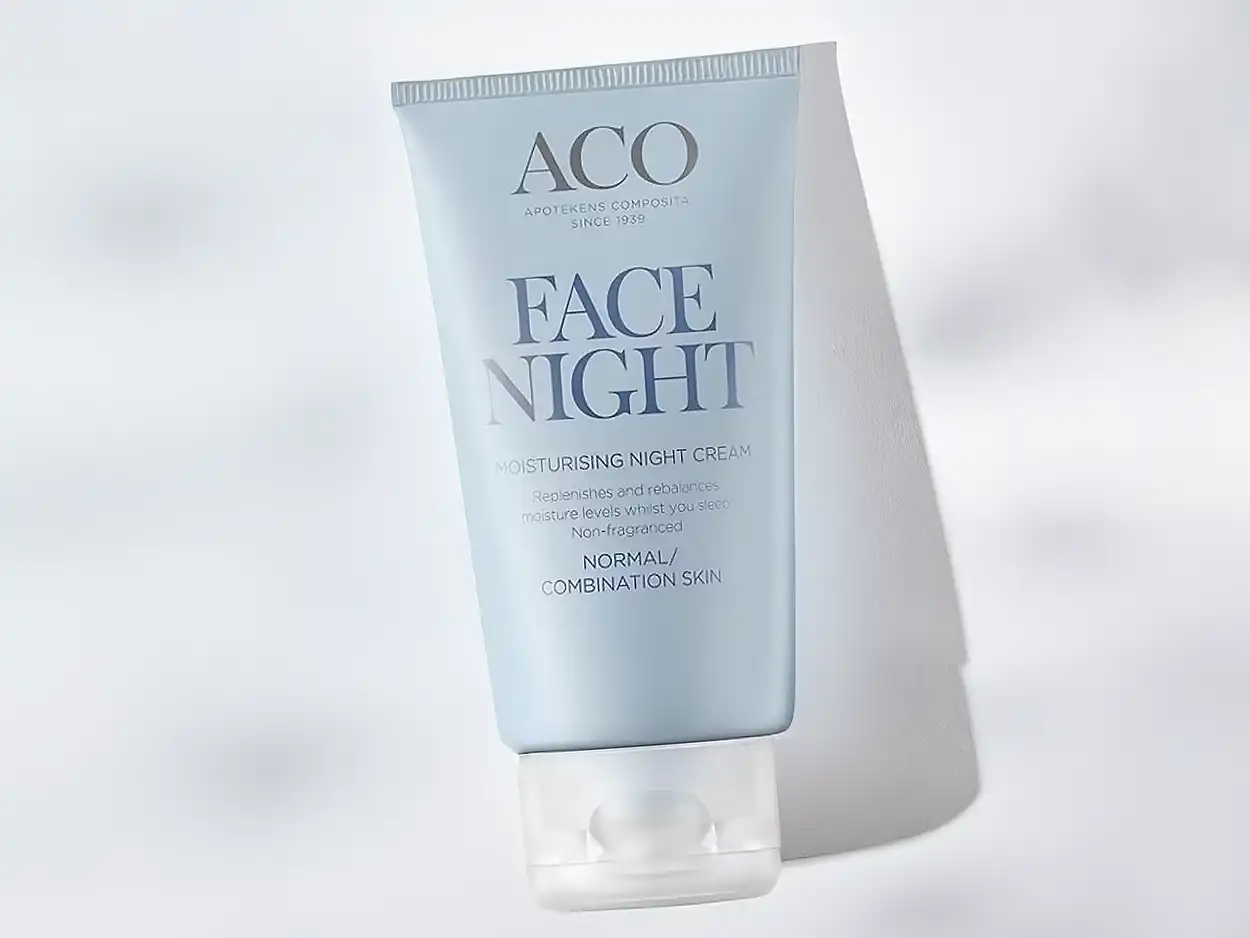ACO has long been the quiet achiever of Scandinavian pharmacy aisles, quietly turning out fragrance-free staples that dermatologists nod at approvingly. If you have missed the name till now, think of it as the reliable friend who never shouts for attention yet always shows up with sensible solutions for temperamental skin.
Enter Face Night Moisturizing Night Cream, a title so committed to reiterating “night” you almost expect the tube to come with a lullaby. According to ACO the formula is designed to flood normal or combination skin with moisture while you sleep, leaning on oils from rapeseed and borage plus soothing bisabolol and protective vitamin E to restore balance more deeply than its day-time sibling.
I put the promises to the test over two full weeks, using the cream nightly to see whether it could earn a permanent spot on my bathroom shelf and justify your hard-earned money.
Disclaimer: this is not paid or sponsored content. All opinions are my own based on personal experience. As always skin responds differently from person to person so your results may vary.
What Is Face Night Moisturizing Night Cream?
Face Night Moisturizing Night Cream is an overnight treatment, meaning it is designed to work while you sleep when the skin’s repair processes naturally peak. Overnight treatments differ from day creams because they do not need to defend against sun or pollution. Instead they focus on replenishing water and lipids lost during the day, helping the skin maintain a balanced moisture level by morning.
This particular formula targets normal and combination skin with a blend of humectants, emollients and soothing agents. Glycerin and urea draw water into the skin, canola and borage oil supply fatty acids that reinforce the barrier and bisabolol aims to calm any mild irritation. Vitamin E is included for its antioxidant role which can help limit the impact of daytime stressors that linger after cleansing. The texture is intentionally richer than a typical day cream so you apply it as the final step of your night routine after cleansing and optional serum.
Used consistently, an overnight cream like this one should leave skin feeling less tight, looking smoother and better prepared to face the next day’s environmental exposure. While results vary by individual, the basic goal is simple hydration support delivered during the hours when you are least likely to touch or wash your face.
Did It Work?
In the name of rigorous skin science I shelved my usual overnight treatment for three whole days before trying this product, feeling every bit the lab-coat rebel. Fourteen nights felt like a fair testing window so I committed to cleansing, patting on a hydrating serum, then sealing everything with a grape-sized dab of the cream from hairline to collarbone.
The first few applications were pleasant if unremarkable. The texture is creamy yet not greasy and the fragrance-free promise holds true. It sank in within a minute leaving a soft satin finish. By morning my cheeks felt comfortably moisturised rather than tight which told me the glycerin and canola oil were doing their job. No miraculous overnight glow, but no clogged pores either.
Midway through the fortnight I noticed some patterns. On cooler nights the cream felt just right, on warmer ones my combination T-zone woke up with a slight film that begged for a gentle cleanse. Layering a silicone-heavy serum underneath occasionally caused the cream to pill, so I stuck to lighter hydrating essences. Still, my barrier behaved nicely: no flakiness around the nose and the faint redness on my chin looked a touch calmer.
By nights eleven to fourteen the results plateaued. My skin remained hydrated and reasonably even but lacked that extra bounce or luminosity that makes you double-take in the mirror. Fine lines around the eyes looked neither worse nor markedly improved. In other words the cream met its baseline promise of moisture support, just without delivering any memorable “wow” moments.
So did it work? Yes, in the sense that it kept my face comfortably hydrated and soothed without irritation. No, in the sense that it did not outperform my current night treatment or inspire me to clear shelf space for a full-size replacement. I will happily finish the tube on travel nights or lazy routines but my long-term collection will stay unchanged.
Main Ingredients Explained
Front and center is glycerin, a classic humectant that pulls water from the environment and the deeper layers of skin to the surface. That immediate shot of moisture is what kept my cheeks from feeling papery by morning. Working alongside it is 5 percent urea, another water magnet that also softens the bonds between dead cells for a subtle smoothing effect. Together they form the hydration backbone of the formula.
For barrier support ACO leans on canola and borage seed oils plus a touch of shea butter. Canola supplies omega-3 and omega-6 fatty acids while borage is one of the richest natural sources of gamma-linolenic acid, a lipid that can help calm mild irritation. Shea contributes occlusive richness that seals everything in. The caveat is that isopropyl myristate and myristyl myristate, both included for that cushiony feel, score high on comedogenic scales. Comedogenic simply means an ingredient has a greater chance of clogging pores in acne-prone skin. If you break out easily patch test first and avoid layering heavy serums underneath.
Niacinamide appears midway down the list at what feels like the sweet spot around 4 percent. That concentration is enough to brighten uneven tone, aid barrier function and even temper excess sebum without risking the flush that can happen at higher levels. Tocopheryl acetate, a stable form of vitamin E, steps in as the antioxidant shield warding off free radicals created by daytime pollution. Bisabolol and allantoin round out the calming squad, both known for reducing redness and supporting wound healing.
The preservative system hinges on phenoxyethanol combined with sodium benzoate which keeps the formula safe for three months after opening. Fragrance is absent, a relief for sensitive noses and reactive skin. All listed components are plant derived or synthetic so the cream is suitable for vegans and vegetarians, provided your personal stance on lab sourced vitamin E checks out.
Expecting mothers often ask whether topical niacinamide, urea or phenoxyethanol are safe during pregnancy. Current research flags no major concerns at the low percentages used here yet medical bodies still advise consulting a doctor before adding any new product to a routine. When hormones are already flipping the moisture switch unpredictably it pays to err on the side of caution.
One last note for ingredient detectives: the pH sits around 5.3 which mirrors healthy skin. That means active molecules such as niacinamide remain stable and your acid mantle stays happy. Overall the ingredient list is short on bells and whistles but long on tried-and-true moisture science which explains the dependable though not dazzling results I experienced.
What I Liked/Didn’t Like
Here is a quick snapshot of what stood out during my two week test.
What Works Well:
- Cushiony texture sinks in quickly yet keeps cheeks comfortable till morning
- No added fragrance so sensitive skin stays calm and the formula plays nicely with actives
- Niacinamide, urea and gentle oils give reliable hydration and barrier support at a wallet friendly price point
What to Consider:
- Rich finish can feel a touch heavy on hot nights or oil prone zones
- Myristyl myristate and isopropyl myristate may not suit those who clog easily
- Occasional pilling when layered over silicone heavy serums means some routine tweaking might be needed
My Final Thoughts
Finding an overnight treatment that treats your skin kindly yet still feels like a small luxury is half the battle of a solid routine. After clocking fourteen nights with ACO Face Night Moisturizing Night Cream I can say it is a steady co-pilot rather than a charismatic lead. It gives dependable hydration, plays nicely with most serums and keeps reactive skin settled, but it never quite pushed my complexion into that coveted ‘did you sleep nine hours?’ territory. I have rotated through more night creams than I care to admit so I feel I gave this one a fair shake and, judged on its own promises, it earns a respectable 7/10.
Who will be happiest? Normal to combination faces that crave straightforward moisture without fragrance or drama. Who might pass? Very dry skins needing heavy occlusion and oily or congestion-prone types wary of richer esters. Would I recommend it to a friend? Yes, though with the caveat that it is a backstage workhorse rather than a show-stopping star.
If you are curious but still shopping around, a few products I have emptied recently deserve mention. Nocturnal Revive Cream by Deascal is the best all-rounder I have tried this year, ticking hydration, barrier support and price in one swipe. For a featherlight yet cushiony feel Squalane + Ectoin Overnight Rescue by BIOSSANCE is brilliant, especially when central heating is on full blast. Laneige’s Water Sleeping Mask remains my go-to when I want to wake up looking like I drank two extra litres of water. Finally RoC’s Multi Correxion Even Tone and Lift Night Cream brings a gentle tingle of exfoliation that noticeably smooths texture over a month.
Before letting any cream move in for the night remember a few basics: patch test first on the jawline (sorry for sounding like an over-protective parent), keep expectations realistic and understand that any plumpness or glow will slip away if you stop using the product consistently. Skin care is a marathon, not a sprint, even while you are asleep.

